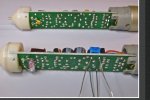Just curious about everyone's opinion.
I record now with two AT-2035 mics (LDC). I have a couple of SDC, a Rode NT-5 and a AKG Perception. I also have a MXL 991. I haven't recorded with my SDC mics in over a year, but I'm going to work with them soon. I'm pretty sure I was mic'ing too close and with the input gain too low back during the time I used them. I ended up just increasing the room "noise" and had proximity effect as well. I don't have a treated room, just a spare bedroom to record in, so there's that too.
I record now with two AT-2035 mics (LDC). I have a couple of SDC, a Rode NT-5 and a AKG Perception. I also have a MXL 991. I haven't recorded with my SDC mics in over a year, but I'm going to work with them soon. I'm pretty sure I was mic'ing too close and with the input gain too low back during the time I used them. I ended up just increasing the room "noise" and had proximity effect as well. I don't have a treated room, just a spare bedroom to record in, so there's that too.



